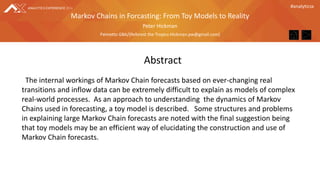1) The document describes a toy model to help explain Markov chains used in forecasting. It involves the metabolic carbon flow in extinct arborescent lycopsids.
2) The toy model uses a transition matrix and state vector to represent the flow of carbon through different states over a diurnal cycle.
3) The toy model demonstrates how Markov chains can be used to model complex real-world processes and help explain sources of change and variability in large Markov chain forecasts.









